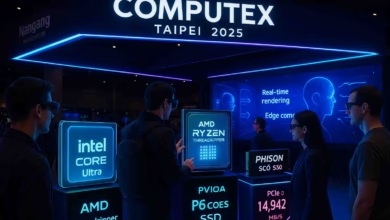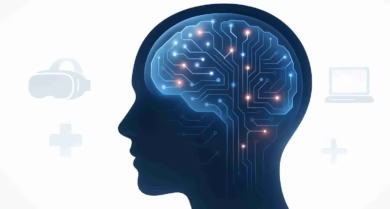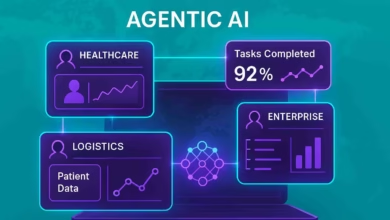Post-Computex 2025: The Rise of AI-Powered Devices and What It Means for You – BytesWall
TAIPEI, Taiwan – Computex 2025 has already set the tech world abuzz with its Day 0 events on May 19, 2025, showcasing AI as the driving force behind the industry’s future. With NVIDIA and Qualcomm unveiling AI supercomputers and processors like the Snapdragon X Series, the event underscores a pivotal shift: AI-powered devices are moving from concept to reality, poised to transform how we live, work, and interact with technology. As the main exhibition kicks off tomorrow, BytesWall Media Team looks beyond the show floor to explore the broader implications of this trend and what it means for consumers and industries in the coming years.
AI PCs: The Next Frontier for Personal Computing
One of the standout themes at Computex 2025 is the rise of AI PCs, a category that’s gaining traction with innovations like Qualcomm’s Snapdragon X Series and Microsoft’s Copilot+ initiative. These devices leverage on-device neural processing units (NPUs) to handle AI tasks locally, reducing reliance on cloud computing. For consumers, this means faster, more secure, and energy-efficient experiences—whether it’s real-time language translation, AI-enhanced video editing, or personalized gaming optimizations.
Qualcomm’s keynote today highlighted how the Snapdragon X Series can power laptops that perform generative AI tasks on the fly, such as creating presentations or editing photos with minimal latency. Meanwhile, NVIDIA’s collaboration with MediaTek on ARM-based chips for Copilot+ PCs suggests a competitive landscape that could drive prices down and accessibility up. Industry analysts predict that by 2026, over 60% of new laptops will ship with AI capabilities, making these features standard rather than premium.
Smart Home Devices: AI at Your Fingertips
Beyond PCs, AI is making significant inroads into smart home technology, a trend that’s expected to accelerate post-Computex. Companies like ASUS and Acer are showcasing prototypes of AI-driven smart hubs that can manage home ecosystems—from lighting to security—using natural language processing. These devices learn user habits, adjusting settings automatically to save energy or enhance comfort, such as dimming lights when you’re winding down for the night.
For example, Acer’s new smart hub, teased at Computex, integrates with its ecosystem of devices to offer predictive maintenance for appliances, alerting users to potential issues before they arise. This could reduce household maintenance costs by up to 15%, according to early estimates. As AI continues to evolve, smart home devices are expected to become more intuitive, potentially integrating with health wearables to monitor well-being and suggest lifestyle adjustments.
Industrial Impact: Robotics and Automation
NVIDIA’s Isaac GR00T robotics platform, introduced at Computex, signals a major leap for industrial applications. By open-sourcing its robotics blueprint in July 2025, NVIDIA is enabling manufacturers to develop humanoid robots for tasks like assembly, quality control, and logistics. This move could lower the barrier to entry for smaller firms, democratizing access to automation technologies.
In industries like manufacturing and healthcare, AI-powered robots are expected to boost productivity by 20% over the next five years, according to industry forecasts. For instance, Foxconn’s collaboration with NVIDIA to build an AI supercomputer in Taiwan could accelerate the adoption of smart manufacturing, where robots handle repetitive tasks while humans focus on innovation and oversight. However, this shift raises questions about workforce displacement, with experts urging companies to invest in reskilling programs to mitigate job losses.
Challenges and Ethical Considerations
While the potential of AI-powered devices is immense, challenges remain. Privacy concerns are at the forefront, as on-device AI requires access to vast amounts of user data to function effectively. Companies will need to prioritize transparent data policies to maintain consumer trust. Additionally, the energy demands of AI hardware, particularly in data centers, could strain global resources unless paired with sustainable practices—something Computex exhibitors like Seagate and Infineon are addressing with energy-efficient solutions.
Ethically, the rise of AI in robotics and automation poses questions about accountability. If an AI-powered robot makes a costly error in a factory or a smart hub misinterprets a user’s command, who is responsible? Regulatory frameworks will need to evolve alongside these technologies to ensure safety and fairness, a topic likely to dominate tech discussions in the coming years.
What’s Next for Consumers and Businesses
For consumers, the rise of AI-powered devices means more seamless and personalized tech experiences, but it also requires a learning curve to fully utilize these capabilities. Businesses, on the other hand, stand to gain from increased efficiency and innovation, provided they navigate the ethical and logistical challenges. As Computex 2025 continues, the focus on AI Next is a clear indicator that these technologies will shape the tech landscape for years to come.
Looking ahead, events like AMD’s Advancing AI 2025 conference on June 12 and Apple’s WWDC 2025 from June 9 to 13 will likely build on Computex’s momentum, unveiling more AI-driven products and software updates. For now, the message from Taipei is clear: AI is no longer a buzzword—it’s the foundation of the next tech revolution.
Dive deeper into the AI revolution! Follow BytesWall Media for the latest tech trends and explore our resources to stay ahead in this fast-evolving landscape.
Sources
- Official Computex 2025 Website
- NVIDIA Computex 2025 Announcements
- Electronicspecifier.com
- X posts from tech industry analysts




